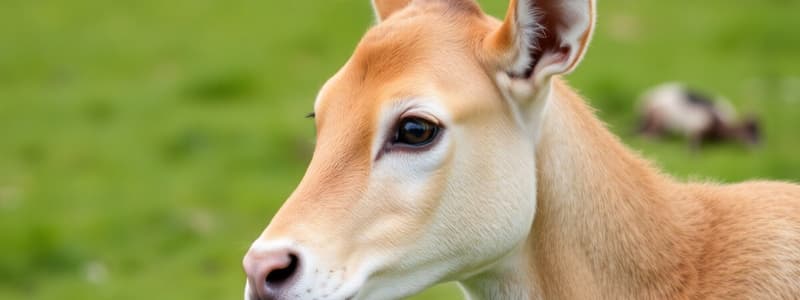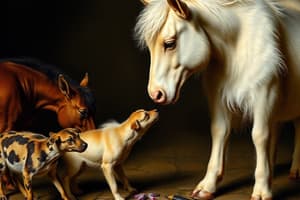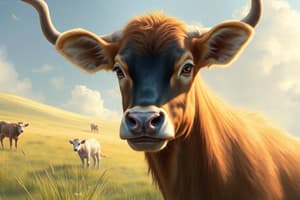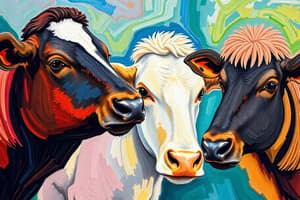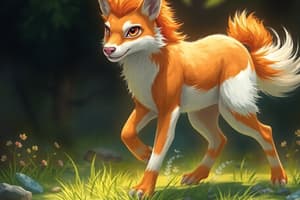Podcast
Questions and Answers
What is the definition of domestication?
What is the definition of domestication?
Domestication is the process whereby a population of living organisms is changed at the genetic level through selective breeding to accentuate traits desirable to humans.
List two common changes in traits observed in animals due to domestication.
List two common changes in traits observed in animals due to domestication.
Tameness, coat color changes, reduced skull size, reduced teeth size, morphological changes, floppy ears.
What was the primary objective of Belyaev's fox experiment?
What was the primary objective of Belyaev's fox experiment?
To simulate the process that turned wolves into present-day dogs by selectively breeding foxes based on temperament.
How does domestication, according to the neural crest hypothesis, relate to the size of the neural crest?
How does domestication, according to the neural crest hypothesis, relate to the size of the neural crest?
Briefly explain the difference between the commensal pathway and prey pathway in the context of domestication.
Briefly explain the difference between the commensal pathway and prey pathway in the context of domestication.
What are the adrenal glands' role in tameness, and what hormones are involved?
What are the adrenal glands' role in tameness, and what hormones are involved?
Give an example of an animal that follows an extensive animal system and an animal that follows an intensive animal system.
Give an example of an animal that follows an extensive animal system and an animal that follows an intensive animal system.
What does the term 'gilt' refer to in pork production?
What does the term 'gilt' refer to in pork production?
What is the gestation period for a sow?
What is the gestation period for a sow?
Describe one characteristic of modern swine production in Canada.
Describe one characteristic of modern swine production in Canada.
Why is colostrum important for newborn calves?
Why is colostrum important for newborn calves?
Briefly explain how supply management in Canada stabilizes the price of dairy products.
Briefly explain how supply management in Canada stabilizes the price of dairy products.
Name the three sectors of the North American Beef industry in order.
Name the three sectors of the North American Beef industry in order.
What are forages and why are they important for cow-calf nutrition?
What are forages and why are they important for cow-calf nutrition?
What are two of the most dominant breeds of cattle?
What are two of the most dominant breeds of cattle?
How should you identify animals under Canada's Traceability Program?
How should you identify animals under Canada's Traceability Program?
In poultry terminology, what is a 'layer'?
In poultry terminology, what is a 'layer'?
Explain one advantage and one disadvantage of supply management for poultry production in Canada.
Explain one advantage and one disadvantage of supply management for poultry production in Canada.
What is one reason chicken is the most consumed meat in the world?
What is one reason chicken is the most consumed meat in the world?
Provide one example of a coat color in horses that is associated with selective disadvantages.
Provide one example of a coat color in horses that is associated with selective disadvantages.
Describe one way that breeding for specific traits has had detrimental effects on horses .
Describe one way that breeding for specific traits has had detrimental effects on horses .
Where did the Equus genus (horse) originate and how did it spread?
Where did the Equus genus (horse) originate and how did it spread?
What is the Latin name for domestic swine?
What is the Latin name for domestic swine?
Name one of the major Canadian swine breeds.
Name one of the major Canadian swine breeds.
Define the term 'farrowing' in swine production.
Define the term 'farrowing' in swine production.
How are swine operations experiencing changes?
How are swine operations experiencing changes?
Why are cats easier to revert to feral than dogs?
Why are cats easier to revert to feral than dogs?
Name one health benefit of pet ownership.
Name one health benefit of pet ownership.
How does animal assisted therapy differ from animal assisted activities?
How does animal assisted therapy differ from animal assisted activities?
What is one thing that dairy cattle should have to achieve their genetic potential?
What is one thing that dairy cattle should have to achieve their genetic potential?
Flashcards
What is domestication?
What is domestication?
Process of genetically changing a population of organisms through selective breeding to benefit humans.
Examples of domestic animals
Examples of domestic animals
Pets (cats, dogs), horses, and cows, are domesticated to benefit humans.
Degrees of domestication
Degrees of domestication
Wild, tamed, semi-domesticated, and domesticated, refers to an animal's dependence on humans
Traits changed by domestication
Traits changed by domestication
Signup and view all the flashcards
Belyaev's fox experiment
Belyaev's fox experiment
Signup and view all the flashcards
What is tameness?
What is tameness?
Signup and view all the flashcards
Hormones related to tameness
Hormones related to tameness
Signup and view all the flashcards
Neural crest hypothesis
Neural crest hypothesis
Signup and view all the flashcards
Domestication's impact on the neural crest
Domestication's impact on the neural crest
Signup and view all the flashcards
Commensal pathway
Commensal pathway
Signup and view all the flashcards
Prey pathway
Prey pathway
Signup and view all the flashcards
What is an extensive system?
What is an extensive system?
Signup and view all the flashcards
Examples of extensive systems
Examples of extensive systems
Signup and view all the flashcards
What is an intensive system?
What is an intensive system?
Signup and view all the flashcards
Examples of intensive systems
Examples of intensive systems
Signup and view all the flashcards
Beef production sector types
Beef production sector types
Signup and view all the flashcards
Cattle lifecycle terms
Cattle lifecycle terms
Signup and view all the flashcards
Swine lifecycle terms
Swine lifecycle terms
Signup and view all the flashcards
Supply management in Canada
Supply management in Canada
Signup and view all the flashcards
Why is colostrum important?
Why is colostrum important?
Signup and view all the flashcards
Beef production system
Beef production system
Signup and view all the flashcards
Canada's Traceability Program
Canada's Traceability Program
Signup and view all the flashcards
Dominant cattle breeds
Dominant cattle breeds
Signup and view all the flashcards
Poultry terminology
Poultry terminology
Signup and view all the flashcards
Supply management effects in Canada
Supply management effects in Canada
Signup and view all the flashcards
Benefits of pet ownership
Benefits of pet ownership
Signup and view all the flashcards
Risks of pet ownership
Risks of pet ownership
Signup and view all the flashcards
Animal assisted therapy
Animal assisted therapy
Signup and view all the flashcards
Animal assisted activities
Animal assisted activities
Signup and view all the flashcards
Maximizing mammary gland utilization
Maximizing mammary gland utilization
Signup and view all the flashcards
Study Notes
Lecture 1: Domestication and Animal Traits
- Domestication is the process of genetically changing a population of living organisms through selective breeding that benefits humans.
- Domesticated animals include pets like cats and dogs, as well as livestock like horses and cows.
Degrees of Domestication
- Wild animals exhibit "fight or flight" responses.
- Tamed animals show dependence on humans.
- Semi-domesticated animals have a human-animal relationship.
- Domesticated animals are reliant on humans.
Common Trait Changes Due to Domestication
- Changes in tameness are linked to adrenal glands.
- Coat color changes link to melanocytes.
- Chondrocytes and odontocytes relate to reduced skull and teeth size, respectively.
- Morphological changes and floppy ears can also occur.
Belyaev's Fox Experiment
- Foxes were selected for temperament, starting with 465 individuals.
- The objective was to simulate wolf domestication into present-day dogs.
- Initial selection was based on behavior: 30% extremely reactive, 40% moderately reactive, 20% fearful, and 10% quiet and exploratory.
- Breeding criteria involved flight threshold distance.
Tameness and Hormones
- Tameness involves reduced release of stress hormones, resulting in a reduced fight-or-flight response and decreased reactivity to new situations.
- Hormones are produced by adrenal glands.
- Long-term hormones include glucocorticoids like cortisol, which regulate neonatal development duration.
- Short-term hormones include catecholamines like epinephrine and norepinephrine.
- Domestic animals exhibit a reduction in these hormones compared to wild animals.
Neural Crest Hypothesis
- Genetic changes to neural crest cells influence domestication traits.
- Domestication decreases the size of the neural crest, reducing the population of cells derived from it.
- Tameness results from reduced stress hormone synthesis, as cells producing these hormones originate from the neural crest.
- Smaller numbers of cells involved is characteristic of domestication syndrome.
Wolf Domestication
- Wolves with short flight distances took advantage of food waste from humans, gaining a competitive advantage
- Those wolves bred together, developing domestication syndrome.
Domestication Pathways
- Commensal pathway: Habituation leads to partnership then directed breeding
- Prey pathway: Prey leads to game management, then herd management, and finally directed breeding.
Lecture 2: Animal Systems and Production
Extensive vs. Intensive Animal Systems
- Extensive animal systems involve minimized capital inputs, unprocessed diets of low nutrient density and high fiber, being non-confined, and minimized handling
- Examples: Beef cattle, sheep, and goats.
- Intensive animal systems involve significant capital inputs, processed nutrient-dense diets, confinement production, and economies of scale.
- Examples: Pork, dairy, and poultry.
Sector Terms
- Cow-calf operations are primary in extensive production, using pasture and rangeland.
- Backgrounding/Stocker: Managed with forage/pasture diets and slow growth.
- Feedlot/Finishing: Intensive production uses primarily concentrated diets, sometimes with pasture in feedlots.
- Packing sector.
Animal Lifecycle Terms
- Cow: Mature female.
- Heifer: Young female.
- Bull: Sexually mature, uncastrated male.
- Steer: Castrated male before sexual maturity.
- Calf: Neonatal to 5 months old.
Pork terms
- Sow: Mature female pig.
- Gilt: Immature female pig before 2nd pregnancy
- Boar: Mature male pig
- Barrow: Castrated male pig
- Piglet: Neonatal pig before weaning
- Farrowing: Giving birth to piglets.
Swine Production in Canada
- Intensive industry with pigs typically raised in total confinement.
- Biosecurity on commercial farms is very important, with limited visitors.
- Breeding through artificial insemination, gestation is 3 months, 3 weeks, 3 days.
Farrowing
- Sows are kept in individual crates.
- Average litter size is 15 piglets.
- Average birth weight is 1.2 kg.
- Colostrum intake occurs in the first 6 hours.
- Sows typically have 12 teats.
Weaning and Grow-Finish
- Weaning is abrupt, piglets are moved to a nursery.
- Piglets transition from milk to solid feed and are mixed with other piglets at 21-28 days old.
- Grow-finish phase occurs after 5 weeks in the nursery.
- Housed in large groups, diets change as pigs mature and are ready for market in 15 weeks, at 125-130 kg.
Dairy Production
- Lifecycle: Lactation cycle to lifespan to calves
Parturition and Milk Fever
- Requires that cows mobilize calcium from the skeleton
- Insufficient calcium causes muscle tremors, staggering, lying flat, heart failure and death
- Treat with: Intravenous calcium
Supply Management in Canada
- Milk production is designed to meet the demand of Canadians with limited exports and imports
- The quantity of milk required is set by each province
- Quota is the license to produce a set amount of milk.
- The national marketing agency determines production amounts and sets quotas for each province.
- Minimum prices are guaranteed to producers.
- High tariffs make imported dairy products expensive.
Importance of Colostrum
- Calves are born with no immunoglobins in their bloodstream.
- For Passive Immunity, the small intestine of the newborn can absorb these antibodies into the blood for the first 24 hours.
- Antibodies are Y-shaped proteins that bind to bacteria and viruses to help prevent disease.
Lecture 3: Beef Industry and Forages
North American Beef Industry
Sectored Production: Begins with cow-calf operations Followed by backgrounding Then feedlot Ending with the packing sector
- Features over 90,000 producers
- Predominantly family-run
- Features about 15 million cattle
Forages in Cow-Calf Management
- Forages such as pasture, hay, straw, and silage are the foundation of the beef industry.
- Feed cost is of greatest variable cost in beef production
- Forages focus on providing: Energy, Protein, Minerals, Vitamins, and Water.
Canada's Traceability Program
- Animal identification- radio frequency identification tags
- Animal identification including individual and premise IDs, cattle must have IDs to leave a property.
- Includes premise identification and animal movement tracking.
Cattle Breeds
- Dominant breeds include Angus, Simmental, Hereford, Charolais, and Limousin.
- Breeds vary in colour, carcass quality, behaviour, frame size, and feed efficiency
Weaned Calf Sales
- Sold in groups at auction marts to feedlot buyers and Internet/Video sales
- Forward contracts with feedlots, delivery of calves eliminates the 'sale barn'.
Lecture 4: Poultry Terminology and Supply Management
Poultry Terminology
- Broiler: Meat chicken.
- Layer: Table egg production chicken.
- Rooster: Male chicken.
- Tom: Male turkey.
- Hen: Female turkey or chicken.
Chicken Consumption
- Supply management system - Canada produces as much chicken as is consumed.
- Family farms in Canada.
- Producers receive steady income.
- Not family owned in USA
- Many vaccines exist, however politicians sometimes restrict their usage.
- Over 1000 broilers qualify as "commercial".
Advantages of the Poultry Supply System
- Producers have steady income and no oversupply
- Producers make enough money that they can support additional welfare initiatives
- Boards have say in practices for animal welfare of birds
Disadvantages of the Poultry Supply System
- Product is more expensive for consumers and requires producers to purchase quota
Lecture 5: Horse Evolution, Domestication, and Specialization
Horse Evolution and Domestication
- The horse (Equus) evolved in North America then underwent ancestral migration to Eurasia, spreading across the Eurasian steppes
- Domestication was underway in the form of captive raising, after initial hunting for consumption.
Expansion of Horse Use
- Horses were first used for carrying and hauling.
- Later, horses were used for effective war tactics for riding
- Eventually developed into riding of horses.
Coat Colors and Disadvantages
- Colors with selective disadvantages for wild horses includes negative pleiotropic effects.
- Listed are some detrimental effects:
- Grey: Melanomas
- Silver: MCOA-eye disorder
- Leopard Spotting: CSNB
- Overo Pinto: OLWFS
- Splashed white: Deafness
- Overo: Deafness
- White: Embryonic lethal
- Roan: Embryonic lethal
Detrimental Effects of Specialization
- Breeding for small size can cause dwarfism.
- Breeding for heavily muscled quarter horses can cause periodic paralysis.
- Breeding for speed can propagate fragility.
- "Popular sire": disequilibrium between detrimental genes and performance genes
Lecture 6: Swine Production
Origin and Latin Name
- Domesticated in China around 490 B.C and England around 800 B.C
- Latin name for domestic swine: Sus scrofa domesticus.
Canadian Swine Breeds
- Yorkshire: 42% of herd
- Landrace: 32% of herd
- Duroc: 25% of herd
Swine Production System Terminology
- Swine/Pig, Pork/pig meat, Sow/mother pig, Gilt/of breading age but hasn't had piglets, Weaning/Removal of young ones from their mother, Hog/pig ready to be processed, Process harvest/slaughter for meat, Boar/adult male pig kept for breeding purposes, Farrowing/act of parturition in pigs
Pork Production in SK
- SK produces 8.5% of all pigs
- 5th largest producer in hogs
How Swine Operations are Changing
- Advances in technology and transportation
- Economies of scale
Lecture 7: Trends in Pet Ownership
Trends in Pet Ownership
- Cat ownership is greater than dog ownership
- 8.5 million cats as pets, compared to 7.9 million dogs as pets.
- Pet cat costs 2,542 dollars, compared to 2,500 + 1,000 dollars for dogs.
- Ontario has 770 pet stores in 2021 and brick-and-mortar stores are declining with an increase in online purchases.
Domestication Traits of Dogs and Cats
- Dogs started with hunter-gatherer societies and descend from unknown wolfs, started as mutual co-existence and then companionship
- Changed the way that dogs look and the ability to digest carbohydrate-rich diet through amylase enyzyme increase
- Cats are more recent, and not as dependent on or response to humans like dogs
- Domestication has not changed the way cats look and behave and they can easily revert to feral
- Diet and preference in metabolism in domestic cats is unchanged from wild cats
Benefits of Pet Ownership
- Social support.
- Companionship.
- Improved mental health.
- Motivates exercise.
- Animal assisted therapy and activities.
- Teaches empathy, social skills, and self-esteem.
Risks of Pet Ownership
- Infections, parasites.
- Allergies.
- Bites or injury.
- Financial burden.
- Psychological burden when pets die.
- Neglect of animals
Animal Assisted Activities vs. Animal Assisted Therapy
- Animal assisted therapy is part of treatment for those physically, socially, emotionally, or cognitively challenged
- Stated goals for sessions and individual treatment with detailed notes administered by trained health professionals
- Animal assisted activities are casual involving pets and people, with no specificity, normally volunteer run, and can be as long or short as you need.
Lecture 8: Dairy Cattle and Supply Management
Supply Management
- It is designed to meet the demand of Canadians and has limited exports and imports
- The quantity of milk required is set by each province
- The license to produce milk is called a quota.
Dairy Cattle Management
- Bred through artificial insemination to produce a calf every 365 days
- Calves are housed indoors and fed milk or milk replacer
- They shift to a phase of growth and breed between 13-15 months to have their first calf at 22-24 month
Key Aspects of Dairy Cattle Management
- Colostrum management and passive transfer is important
- Changes in milk yield over time
- theImportance of cow-comfort and characteristics of the mammary gland
Optimal conditions for Cows
- A great environment
- Adequate nutrition
- Calm handling
Mammary Gland and Milking
- "Take it or lose it" policy
- Frequent milking in early lactation stimulates cell development in the mammary gland
- Increased cell development has carry-over effects
- Nutrient demand increases tremendously in lactation.
Lecture 9: Indigenous Principles and Aquaculture
Indigenous Peoples of Canada
- Distinct indigenous peoples of Canada with their own culture, history, practices, and beliefs:
- First Nations, Metis, and Inuit.
Sustainable Aquaculture Principles
Features transparency and inclusiveness in:
- First Nations
- Social responsibility
- Environmental responsibility
- Economic responsibility
Aboriginal vs Non-Aboriginal Aquaculture
- Includes unique cultural and spiritual aspects and unique connections to the land
- Includes some mistrust of conventional science
- Unique rights and special access aquatic resources, job creation, and high food prices
Studying That Suits You
Use AI to generate personalized quizzes and flashcards to suit your learning preferences.
